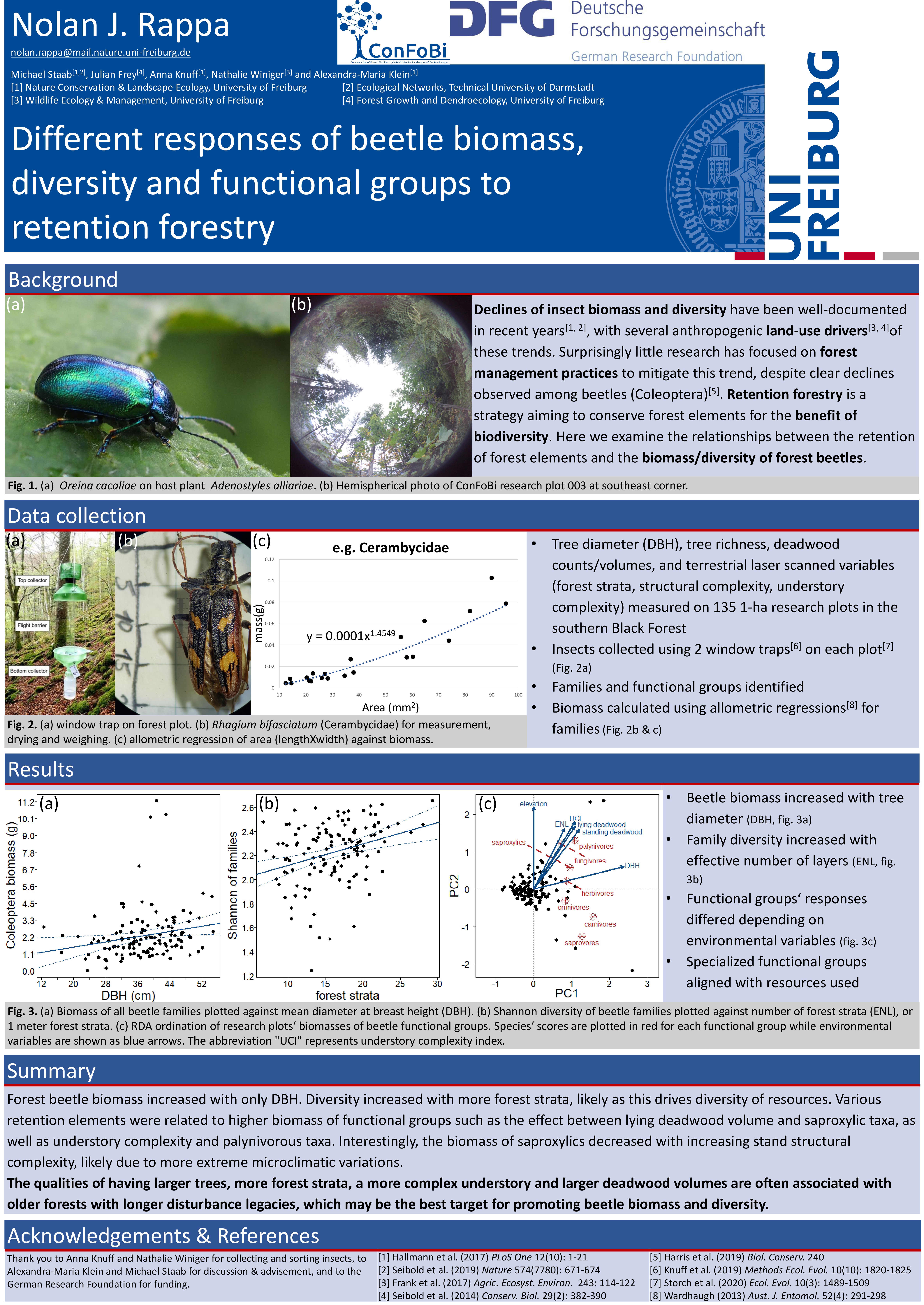ConFoBi - Conservation of Forest Biodiversity
Subproject B3) Plant-Insect Interaktion
1st phase: Diversity and functions of plant-insect interactions
along a forest retention gradient
2nd phase: Diversity, functions and trophic interactions of arthropods
3rd phase: Inter- and intraspecific trait responses to forest maintenance
Team: Prof. Alexandra-Maria Klein (Univ. Freiburg) Dr. Michael Staab (1st Phase/2nd Phase) Dr. Anna Knuff (1st Phase) Dr. Nolan James Rappa (2nd Phase) PhD student Riko Fardiansah (3rd Phase) | Duration: 1st Phase: July 2016-June 2019 2nd Phase: July 2019-June 2022 3rd Phase: July 2022-June 2025 Funding: DFG project / Subproject (B3) in ConFoBi  | ||
| The Research Training Group Conservation of Forest Biodiversity in Multiple-use Landscapes of Central Europe (ConFoBi) combines a multi-scale, ecological study of forest biodiversity with social and economic studies of biodiversity conservation. This integrated approach is designed to establish a lively exchange of knowledge and expertise between scientific researchers and forestry or conservation practitioners. ConFoBi focuses on how the effectiveness of structural retention measures (namely habitat trees and dead wood) for the conservation of biodiversity in multi-functional forests of Central Europe depends on the surrounding landscape. Additionally, it identifies opportunities for cooperation between forestry and conservation sectors to effectively integrate conservation with conventional forest management. In the 1st phase of this subproject “Diversity and functions of plant-insect interactions along a forest retention gradient”, we evaluate how the diversity of Hymenopteran species is related to the quality, heterogeneity and spatial distribution of habitat trees and coarse woody debris within the forest at plot scale and to the amount of forest cover at landscape scale. As research in agricultural landscapes has shown that the effectiveness of management practices to protect biodiversity depends on the surrounding landscape, we test whether this is also true for the studied forest ecosystem. In the 2nd phase "Diversity, functions and trophic interactions of arthropods", the focus will be on biomass, functional diversity and food webs of Hymenoptera and potentially further arthropod taxa. In the 3rd phase "Analysis of inter- and intra-specific trait responses, to forest retention at the stand and landscape scale" by using the existing flight interception and trap nest data. lso will be collected additional data on multitrophic bee/wasp networks in standing deadwood to analyze the food components collected by cavity-nesting bees and wasps. Poster by Nolan James Rappa on the occasion of the 50th annual meeting of the GfÖ from 30.08. - 01.09. 2021 Winner of the poster award of the GfÖ! Additionally, we are working on interactions of both insects and birds with plants. Birds play an important role as seed dispersers while herbivory by insects impacts plant fitness. These relationships are shaped by habitat elements of ecosystems and their surrounding landscapes. Thus, we investigate the effects of certain forest structures, such as the presence of dead wood, and of the landscape on herbivory by gall-inducing insects and on fruit predation by frugivorous birds. The results provide a comprehensive insight into the response of insect diversity, frugivore-plant interactions and related functions to the retention of forest structures intended to conserve forest biodiversity in multiple-use landscapes. |
Publications
1. phase “Diversity and functions of plant-insect interactions along a forest retention gradient”
- Knuff, A., Staab, M., Frey, J., Dorman, C.F., Asbeck, T. & Klein, A.M. (2020): Insect abundance in managed forests benefits from multi-layered vegetation. Basic and Applied Ecology 48: 124-135. Link
- Knuff, A., Winiger, N., Klein, A.M., Segelbacher, G. & Staab, M. (2019): Optimising sampling of flying insects using a modified window trap. Methods in Ecology and Evolution 10: 1820-1825. Link
- (2019): Plant composition, not richness, drives occurrence of specialist herbivores. Ecological Entomology 44: 833-843. Link
2. phase "Diversity, functions and trophic interactions of arthropods"
- Rappa, N.J., Staab, M., Ruppert, L.S., Frey, J., Mello, M.A.R. & Klein, A.M. (2024): Forest structure and heterogeneity increase diversity and alter composition of host-parasitoid networks. Ecological Entomology 49: 257-271. Link
- Burrascano, S., Chianucci, F., Trentanovi, G., Kepfer-Rojas, S., […] Rappa, N.J., et al. & Ódor, P. (2023): Where are we now with European forest multi-taxon biodiversity and where can we head to? Biological Conservation 284: 110176. Link
- Ruppert, L.S., Staab, M., Klingenfuß, S. Rappa, N.J., Frey, J. & Segelbacher, G. (2023): Leaf litter arthropods show little response to structural retention in a Central European forest. Biodiversity and Conservation 32: 3973-3990. Link
- Rappa, N.J., Staab, M., Rupert, L.S., Frey, J., Bauhus, J. & Kein, A.M (2023): Structural elements enhanced by retention forestry promote forest and non-forest specialist bees and wasps. Forest Ecology and Management 529: 120709. Link
- Rappa, N.J., Staab, M., Frey, J., Winiger, N. & Klein, A.M. (2022): Multiple forest structural elements are needed to promote beetle biomass, diversity and abundance. Forest Ecosystems 9: e100056. Link
3. phase "Analysis of inter- and intra-specific trait responses, to forest retention at the stand and landscape scale"

